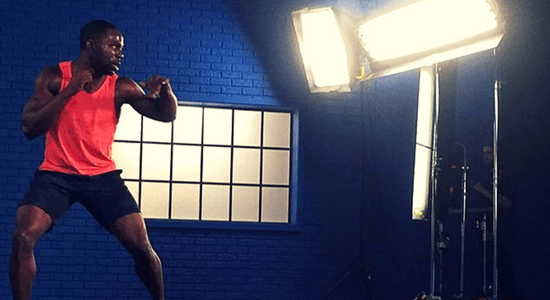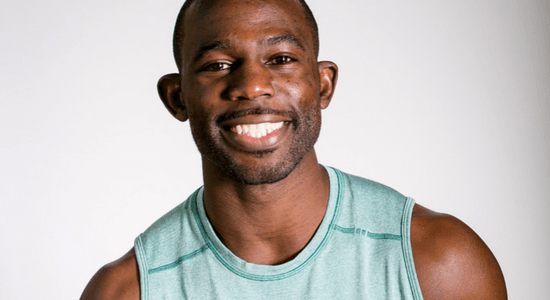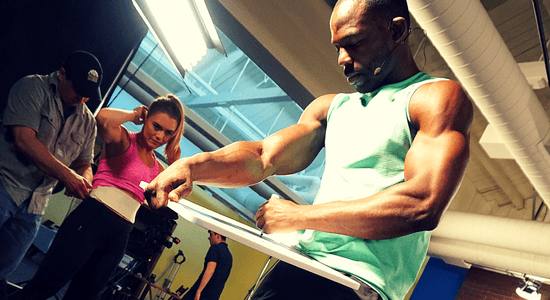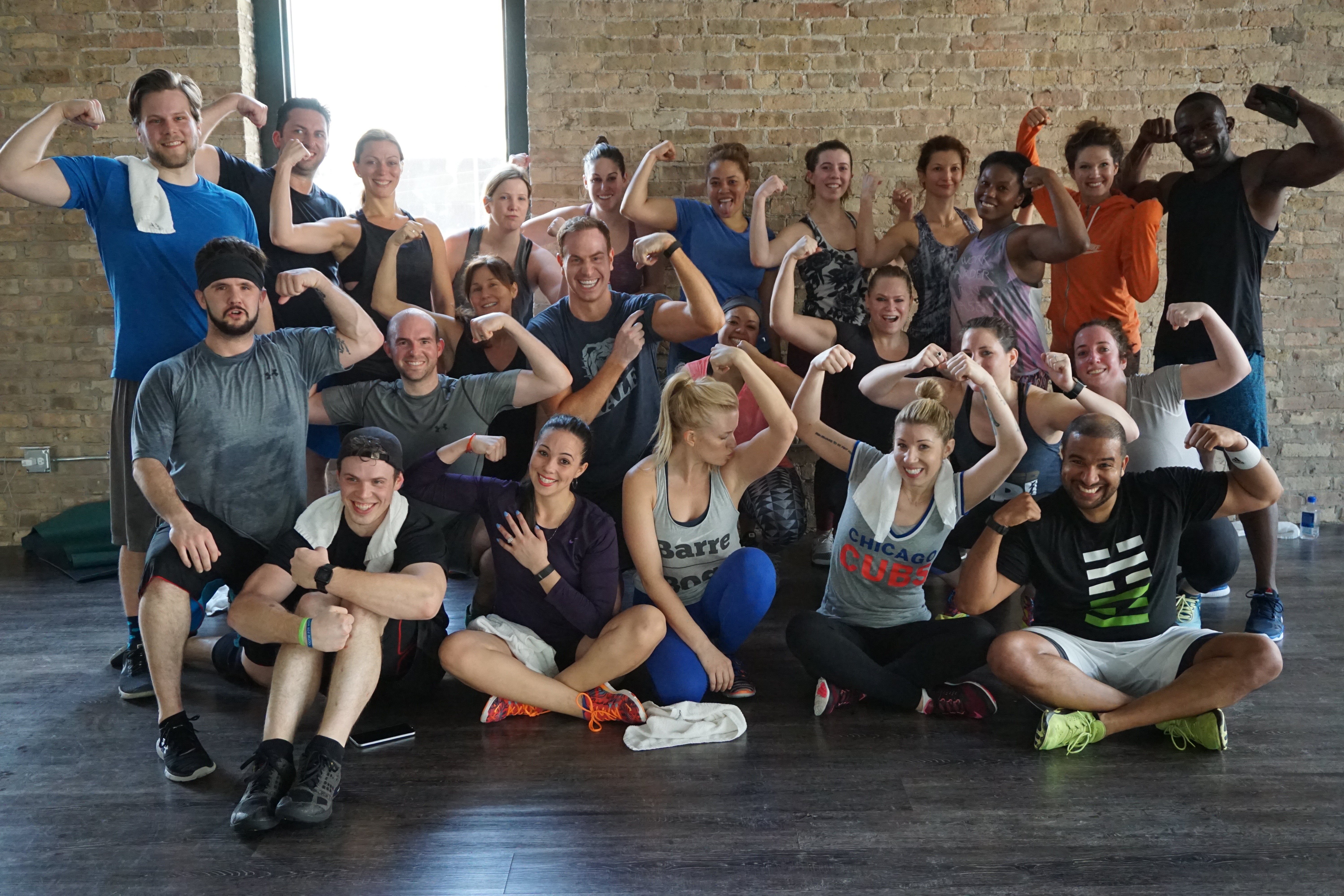Meet Gideon Akande, a native Chicagoan and the 2015 winner of Men’s Health Next Top Trainer, a national competition that granted one winner the opportunity to become a regular Men’s Health contributor and star in his very own workout DVD.
Before that, Gideon was a two-time Chicago Golden Gloves Boxing Champion and a lifelong athlete.
But what makes Gideon’s story so special, one that we think deserves highlighting, is that even after launching his career to new heights Gideon remains that same energetic, motivating trainer he was years before, when he was teaching group exercises at a small boutique in Chicago (he still does).
As you’ll soon read Gideon didn’t just “plan” to enter the competition, knowing with certainty where it would take him.
Class after class, for years, Gideon showed up in that dimly lit room, greeted old and new clients with equal enthusiasm, and as soon as the music started, flooded the room with his signature high energy and a mission to give his clients the best workout he possibly can.
He stayed true to himself, and it took just one client in that room that led him from one amazing opportunity to another, including producing and starring in his own home workout DVD set called Riptensity.
To gain more insight into this entire process and the unique challenges he faced in the creation of his commercial DVD, we talked to Gideon about his experiences before, during, and after the show. Here’s the interview, which has been edited for clarity and brevity.
PTDC: Most of us are probably curious how you came upon the competition to begin with. How did you find out about it?
Gideon Akande: I first heard about Men’s Health Next Top Trainer in early 2015.
I was teaching classes at a high-intensity interval training studio here in Chicago, and the thing is, it’s dark inside the room and the music is blasting; so you really don’t have a chance to interact with your clients or get a chance to see who your clients are.
I later learned that one of the class participants was a sales directors at Men’s Health in Chicago. She came up to me to let me know she really enjoyed my energy, who I was, and the persona I brought. And that’s when she told me about the competition.
“We think you should be a part of it. You should definitely consider it,” she said.
At the time, I didn’t think much of it. I thanked her and went on with my day.
Online competitions are easy to ignore, sure. What changed your mind that led you to finally enter the competition?
Later on that week, the sales director actually sent me a message on Facebook with a link to the site.
I was already on the computer, so I figured it didn’t hurt to look. It turned out to be an online audition process, where I could see all the other competitors and what they were putting out there. The whole premise of the online audition was to create some type of physical challenge and present it and yourself in a two-minute video.
When I looked at the existing videos, they didn’t seem to be anything out of the ordinary, so I thought to myself, I think I can do something and hopefully be at the top of this list. With the help of my videographer friend, who had a nice camera and knew how to work the angles, I came up with my challenge and turned on my personality.
And well, the rest, as they say, is history.
That must’ve been exciting. There are many of us who never got to check out the show. Can you talk briefly about it?
You can watch the show on YouTube. The show was a survivor-style competition series, meaning that if you won a challenge, you’d get an advantage for the next challenge. If you lost a challenge, you’d be sent home. You never really knew what to expect.
We started with eight trainers in the competition, who were selected among hundreds of people who had submitted online auditions. Eight trainers became seven; seven became six; six became five; and finally, I ended up being the winner.
All of the challenges were designed to kick you out of your comfort zone. During the filming of the show, we filmed two challenges each day. If you were watching the show, you may think each challenge was a brand new day. But it was not and it was exhausting.
Imagine waking up at 5 a.m., getting to the film studio by 6, and filming for 12 hours every day. Also, a lot of it was waiting, so in-between the filming and challenges we’d all sit in a break room, foam roll, stretch, and talk amongst ourselves to build camaraderie.
Okay, so as winner of the Men’s Health competition, you got to make your own DVD. What was the process like?
It was a new challenge for me because I was making a DVD for people of all different fitness levels, using all bodyweight exercises—and of course without being able to see them. Before we started filming, I had to prepare for this task.
This involved asking a bunch of friends, class attendees, and anybody who was interested to participate in a six-week test series. I now call it my transformation series, but this test panel of sorts essentially allowed me to fine-tune my plans for Riptensity.
Throughout this test series, I taught a 30-minute class every day. These participants were required to attend four days out of the week to help me develop the product.
https://www.instagram.com/p/BPsLeR-AG9R/?taken-by=getfitwithgiddy
The test participants needed to adhere to a meal plan as well, and if they followed it successfully, they would see results, of course. They were subject to taking before and after pictures and weekly measurements, including body weight, body fat percentage--you know, the whole thing.
I taught every class with the intent of figuring out what I liked, what I didn’t like, what I wanted to change, and what my programming was going to be. It gave me the opportunity to coach things like I would on the camera, know the cues, know what exercises were going to be tough, and just generally decide on my game plan throughout the workout.
What’s something that most people don’t know about the actual filming process of these DVD workouts? Like, is it all fun and games?
While you’re on set, one thing most people don’t realize is, you’ve got a lot of lights and a lot of cameras in front of you. Those lights heat up very quickly, and in addition to that, you have to cut the A/C for the room because the audio equipment would pick up the noise from the A/C unit.
So you’re sweating bullets already in addition to working out pretty darn hard. And just like the Men’s Health Next Top Trainer filming process, you don’t just shoot one DVD per day. You shoot a couple in one day, which sometimes involved up to three full 30-minute workouts.

The first day is actually not dedicated to shooting. It’s more of a prep day, where the staff is setting up the camera and the lights, making sure the angles are right, and making sure that everything is working properly. All of this happens while the talent are practicing and rehearsing as if they’re filming to ensure that when people watch the DVDs they know they’re looking at good and proper form.
And that’s only day one.
Day two is when they actually begin the shooting. For each 30-minute workout, you’re going pretty hard the entire time because you want to motivate the people on the other side of the screen. Imagine that your muscles are sore, you’re achy, you’re on day three of shooting, and you can barely walk, but you have to make it look like you’re fresh, energized, and ready to get after it. It was a great physical challenge, especially for my background talent.
Thankfully, we were able to do everything in one take. You don’t ever want to do it more than once because it’s physically taxing. For me, I did more coaching than exercising, but it still had its own challenges: how do I crescendo my presentation as the workout goes on? How do I start with good energy, maintain that energy, and kind of build toward the finish so that the participant watching the DVD really gives their all?
All throughout, you want to make sure you’re hydrated, foam rolling, stretching, and getting those muscles loose and limber because you’re going to do it all again.
https://www.instagram.com/p/BK_YB-fg57H/
I lost my voice by the end of the last day of shooting, which is something that’s never happened to me before. We still had promos and more videos to shoot, so I drank more tea than I’ve ever had in my life to try to get my voice back. Thankfully, my voice returned, but I was really worried because if it hadn’t it would’ve been really bad.
Once everything was shot, I was confident that they were fantastic workouts and it was up to the post-production team to make the DVDs look pretty.
It sounds like a situation where you had to roll with the punches and just tackle whatever came your way. What do you think was the most difficult process of making the DVD for you?
One of the challenges was that I had to have a beginner, intermediate, and advance level option. How do I make sure that I’m able to craft and cater to a wide array of people with body weight alone?
It took a lot of brainstorming and analyses. I recorded every workout we did and used them to study. I watched the workouts, looked at who was doing what based on their fitness level, and had to be observant of small details, such as whether people were getting a good, quality sweat session and if it was too hard or too easy.
I probably wrote about 50 to 100 different workouts just to figure out how things were going to flow. You can only move your body in so many different ways, so the challenge was how to make it creative and interesting to avoid making my workout DVD just like every other workout DVD. I also got feedback from my participants, so thanks to all of this “prework,” I was able to refine everything for the final Riptensity product.
Since you mentioned that being on the show meant being out of your comfort zone, what sort of things did you have pick up on the fly?
All throughout, I was able to develop those coaching and programming skills and continue to improve my on-camera presence and experience as well.

Normally, I’d like to think I have a personality and can properly describe exercises and talk while demonstrating those exercises, but it’s very different when you’re in front of a camera. It’s a whole new situation.
The challenge for me was trying not to memorize my words because it’s easy to want to know exactly what to say, but that ends up making me sound like an infomercial and less authentic. You have to bring excitement and tons of energy through the camera, but it’s also very easy to kind of get lost and sound like a recording. So I had to learn to speak to the camera as if I was speaking to one of my clients.
Now that you’ve gone through this, what’s the biggest thing that’s changed now, maybe mentally, before you went into the Men’s Health competition?
I’d like to think I’m still the same person. I still teach group class in Chicago. I still have my same personal training clients.
Nothing has changed there. Opportunities have definitely expanded, but mentally, I’m still very confident in what I do and how I do it. The reason I’m so confident and passionate about what I do is people tell me that my passion and my excitement come through naturally. I really love what I do, so you know that hasn’t changed and will never change.
I want to go after everything; and I want to do everything bigger, better, and badder.











